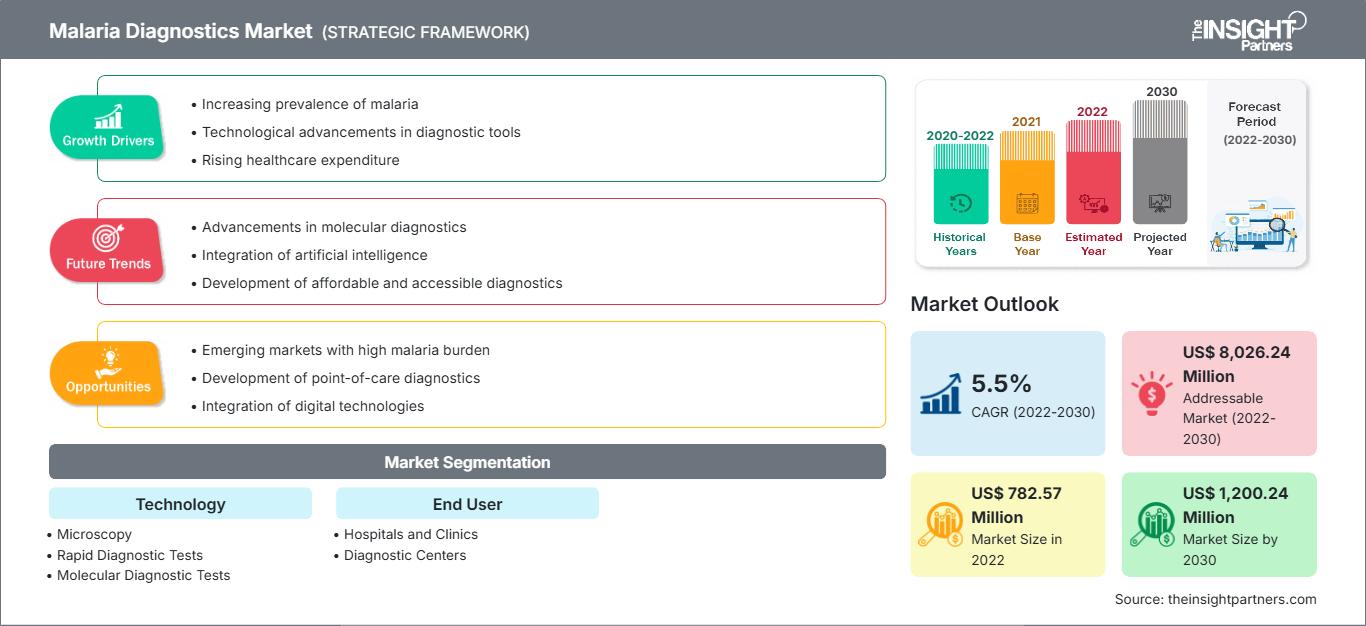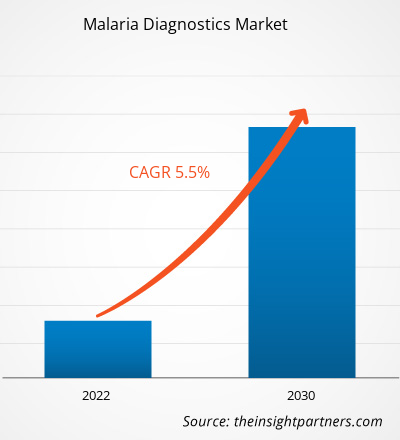[研究报告] 疟疾诊断市场规模预计将从 2022 年的 7.8257 亿美元增长到 2030 年的 12.0024 亿美元;预计该市场在 2022 年至 2030 年期间的复合年增长率为 5.5%。
市场洞察与分析师 观点:
疟疾是由疟原虫引起的一种危及生命的疾病。由于低收入国家疟疾发病率高,以及国际和国家组织在全球范围内实施的疟疾消除计划,疟疾诊断市场正在增长。先进诊断工具的不断推出和有效疗法研究活动的不断增加,进一步促进了市场的增长。
在 COVID-19 大流行之前,近三分之一的疟疾流行国家正在朝着国际目标迈进。许多低发病率国家都参与了世界卫生组织的“消除疟疾2025倡议”,该倡议由25个国家组成,致力于在2025年前消除疟疾。然而,约三分之一的国家进展停滞,而其他国家的疟疾发病率却有所上升。疾病负担较重的国家更倾向于使用诊断检测数据进行分层,并根据地域特点重点实施干预措施,而忽略了检测和筛查在根除疟疾的努力中仍然至关重要的重要性。
由于病例管理和预防工作略有中断,COVID-19疫情爆发的第一年,疟疾病例和死亡人数有所上升。尽管如此,在世界卫生组织、各国疟疾项目和合作伙伴的通力合作下,避免了可能出现的最坏情况——疟疾死亡人数翻倍。难以获得必要的疟疾物资,以及疫情最终如何影响疟疾管理措施的不确定模式。
增长动力:
疟疾是一种急性发热性疾病,由疟原虫引起,并通过受感染的雌性按蚊传播。人类疟疾主要由五种寄生虫引起,其中两种——恶性疟原虫和间日疟原虫——被认为是最大的威胁。此外,恶性疟原虫是最致命的疟疾寄生虫,在非洲大陆传播最为广泛。此外,间日疟原虫是撒哈拉以南非洲以外大多数国家的主要疟疾寄生虫。根据世界卫生组织 (WHO) 发布的《2020 年世界疟疾报告》(WMR),全球报告了 2.41 亿例疟疾病例,而 2019 年记录的病例为 2.27 亿例。据同一来源称,疟疾造成的死亡人数每年增加 69,000 人。其中约三分之二(即 47,000 人)的死亡是由于 COVID-19 大流行期间医疗服务中断造成的;其余三分之一(即 22,000 人)的死亡反映了 WHO 近期计算疟疾死亡率的方法变化(不考虑 COVID-19 中断的影响)。
2020 年,全球约 95% 的疟疾病例和约 96% 的疟疾病例死亡发生在 WHO 非洲区域,报告的总死亡人数中约 80% 是 5 岁及以下儿童。根据2021年世界疟疾报告 (WMR 2021),东南亚国家占全球疟疾负担的约2%,其中印度占2020年估计疟疾病例的83%,疟疾病例死亡人数的82%。因此,全球不同地区疟疾患病率的上升推动了疟疾诊断市场的增长。
市场上只有数量有限的经世卫组织预认证的非Pf mRDT产品。尽管世卫组织预认证的mRDT产品种类繁多,但需求集中在少数特定产品和制造商身上。这限制了市场确保供应多样性、安全性和生产能力的能力。因此,制造商面临着一些国家产品需求低以及不愿或缺乏采用替代产品兴趣等挑战。采用替代品牌的契机可能是由于国家算法选择的品牌发生变化或成本影响所致。
自定义此报告以满足您的要求
您将免费获得任何报告的定制,包括本报告的部分内容,或国家级分析、Excel 数据包,以及为初创企业和大学提供超值优惠和折扣
疟疾诊断市场: 战略洞察

-
获取本报告的主要市场趋势。这个免费样本将包括数据分析,从市场趋势到估计和预测。
报告细分和范围:
“疟疾诊断市场”根据技术和最终用户进行细分。按技术划分,疟疾诊断市场分为显微镜、快速诊断检测 (RDT) 和分子诊断检测。快速诊断检测 (RDT) 细分市场在 2022 年占据最大市场份额,预计在 2022 年至 2030 年期间将实现最高的复合年增长率。按最终用户划分,疟疾诊断市场分为医院和诊所、诊断中心和其他。 2022 年,医院和诊所占据了最大的市场份额。预计诊断中心将在 2022 年至 2030 年期间实现市场最高复合年增长率。
分段分析:
按技术划分,疟疾诊断市场分为显微镜检查、快速诊断检测 (RDT) 和分子诊断检测。
快速诊断检测 (RDT) 细分市场在 2022 年占据了最大的市场份额,预计在 2022 年至 2030 年期间实现市场最高复合年增长率。通过显示人体血液中存在疟原虫,疟疾快速诊断检测 (RDT) 有助于诊断疟疾。RDT 提供了一种临床诊断或显微镜检查的替代方案,尤其是在无法获得高质量显微镜检查服务的情况下。恶性疟原虫或间日疟原虫是某些快速诊断检测 (RDT) 唯一能够识别的种类,但其他快速诊断检测 (RDT) 可以识别四种:恶性疟原虫、间日疟原虫、三日疟原虫和卵形疟原虫。通常,检测时会刺破手指抽血。
按最终用户划分,疟疾诊断市场可分为医院和诊所、诊断中心和其他。随着全球患者数量的增加,医院和诊所也在显著发展。它们在低成本的环境中提供高效的治疗。由于快速的周转时间、低成本和便捷的获取方式,RDT 的使用日益受到重视,这是诊所在疟疾诊断市场占据主导地位的主要原因之一。
区域分析:
全球疟疾诊断市场按地理区域划分为北美、欧洲、亚太地区、南美和中美以及中东和非洲。由于美国等发达国家加大投入、患者人数增加以及世界卫生组织 (WHO) 日益重视降低非洲国家的疟疾死亡率,预计中东和非洲地区将在预测期内保持市场主导地位。根据世界卫生组织 2022 年 7 月发布的数据,撒哈拉以南非洲地区可能占疟疾病例总数的约 95%,死亡人数占比约为 96%。
疟疾诊断市场
疟疾诊断市场The Insight Partners 的分析师已详尽阐述了预测期内影响疟疾诊断市场的区域趋势和因素。本节还讨论了北美、欧洲、亚太地区、中东和非洲以及南美和中美洲的疟疾诊断市场细分和地域分布。
疟疾诊断市场报告范围
| 报告属性 | 细节 |
|---|---|
| 市场规模 2022 | US$ 782.57 Million |
| 市场规模 2030 | US$ 1,200.24 Million |
| 全球复合年增长率 (2022 - 2030) | 5.5% |
| 历史数据 | 2020-2022 |
| 预测期 | 2022-2030 |
| 涵盖的领域 |
By 技术
|
| 覆盖地区和国家 |
北美
|
| 市场领导者和主要公司简介 |
|
疟疾诊断市场参与者密度:了解其对业务动态的影响
疟疾诊断市场正在快速增长,这得益于终端用户需求的不断增长,而这些需求的驱动因素包括消费者偏好的演变、技术进步以及对产品优势的认知度的提升。随着需求的增长,企业正在扩展产品线,不断创新以满足消费者需求,并抓住新兴趋势,从而进一步推动市场增长。

- 获取 疟疾诊断市场 主要参与者概述
行业发展和未来机遇:
疟疾诊断市场领先企业的各种战略发展如下:
- 2022年2月,肯尼亚医学研究所 (KEMRI) 推出了用于疟疾检测的 Plasmochek。Plasmochek 旨在检测疟原虫,这是一种导致疟疾的寄生虫。该试剂盒利用针对恶性疟原虫富组氨酸蛋白 II 和乳酸脱氢酶的特异性抗体来检测疟疾感染。
- 2019年12月,Access Bio 和 Global Good(前者的合作伙伴)开发了一种新的超灵敏快速诊断检测 (uRDT),其在识别富组氨酸蛋白 2 (HRP2) 抗原方面的灵敏度比现有的 uRDT 高出五倍。此外,人们还开发了各种工具来改进疟疾诊断。
竞争格局和主要公司:
Access Bio., Inc.;雅培实验室;Premier Medical Corporation Pvt. Ltd.;Sysmex Partec GmbH;bioMerieux;Beckman Coulter Inc.;西门子医疗;Leica Microsystems GmbH;尼康公司;奥林巴斯公司;以及Bio-Rad Laboratories Inc.是疟疾诊断市场的杰出公司。这些公司专注于新技术、升级现有产品和地域扩张,以满足全球日益增长的消费者需求。
- 历史分析(2 年)、基准年、预测(7 年)及复合年增长率
- PEST和SWOT分析
- 市场规模、价值/数量 - 全球、区域、国家
- 行业和竞争格局
- Excel 数据集
近期报告
客户评价
购买理由
- 明智的决策
- 了解市场动态
- 竞争分析
- 客户洞察
- 市场预测
- 风险规避
- 战略规划
- 投资论证
- 识别新兴市场
- 优化营销策略
- 提升运营效率
- 顺应监管趋势






















 获取免费样品 - 疟疾诊断市场
获取免费样品 - 疟疾诊断市场